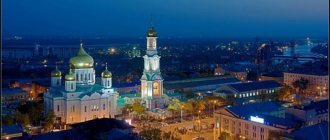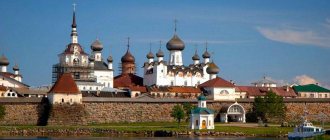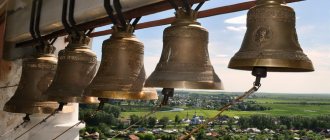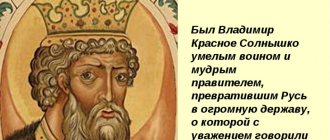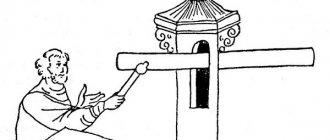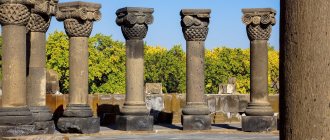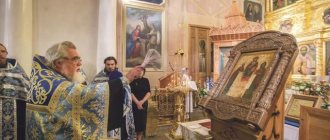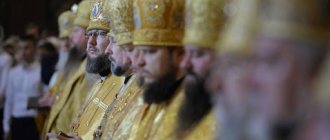History of monasticism
“Monasticism is external and internal. You cannot ignore the external, but you cannot be satisfied with it alone either. The external alone without the internal even brings harm. External monasticism can be likened to plowing the earth. No matter how much you plow, nothing will grow if you don’t sow anything. Inner monasticism is sowing, and millet is the Jesus Prayer. Prayer illuminates the entire inner life of a monk, gives him strength in struggle, and is especially necessary when enduring sorrows and temptations...”
(Reverend Barsanuphius of Optina).
A monk (Greek μοναχός - single, single) is a member of a religious community, in accordance with a vow (oath) leading an ascetic life either within the monastic community (brotherhood), or in solitude, as a hermit.
These words of St. Hesychius fully reflect the life of a true monk. What is monasticism and why are monasteries needed in the modern world?
A monk is an Orthodox Christian who has renounced worldly life and taken vows:
– virginity (a monk cannot marry);
– obedience (a monk must obey the abbot in everything, without relying on his own will and thoughts);
– non-acquisitiveness or poverty (a monk should not have any property, everything is in common with other monks).
Monasticism originated in Egypt in the second half of the 3rd century. The first monk was Anthony the Great, he lived in the desert for more than 90 years, endured difficult trials: hunger, thirst, cold, heat, temptations and devilish attacks. People from all over the world flocked to such great ascetics and settled nearby. Monasteries began to form. In them the monks lived and worked together under the strict guidance of an experienced elder (abbot) according to strict rules.
Monasticism in Russia
In Rus', monasticism gained great popularity and people's love. The first monastery was founded in 1051 by Anthony of the Pechersk in Kyiv and was named the Kiev-Pechersk Lavra. At this time, other monasteries were built in Kyiv: Dimitrievsky, Spassky Berestovsky, Klovsky Vlakhernsky. Monasteries began to appear on the map of the country more and more often. Each ruler sought to found a monastery in his capital city.
The monasteries of Russia became not only places of solitary prayer for monks, but also large educational centers. Christians from all over the country flocked to Orthodox monasteries for advice from experienced elders, asking for prayer and material help. Orthodox shrines have had to endure many trials over their long existence, but even today Russian monasteries are being revived or built in new places.
Operating monasteries in Russia are favorite places of pilgrimage for Orthodox Christians. Here you can retire from the bustle of the world and gain spiritual strength, get advice from experienced priests and work for the Glory of God.
Holy Trinity Sergius Lavra (Sergiev Posad, Moscow region)
The significance of the monastery for the Tambov region
During the years of great trials, the consistory took upon itself the work of raising funds for the benefit of refugees and victims, as well as for the benefit of families left without a breadwinner, for the treatment of the wounded and the creation of hospitals in the Patriotic War of 1812, during the Crimean Campaign and in the First World War. In the Kazan Monastery, sisters of mercy who voluntarily went to the front received blessings. Its bells have repeatedly called people to prayers for the victims of war.
It is significant that in 1793, in the Kazan Monastery, the Reverend Theophilus ordained the Monk Seraphim of Sarov as a hieromonk.
The Kazan Mother of God Monastery was a major social and public center of Tambov. Over the centuries, the consistory archive has accumulated unique documentary material on the history of spiritual culture and education in the region.
The most famous monasteries in Russia
Trinity-Sergius Lavra
The largest monastery in Russia. It was founded in 1337 by one of the most famous Russian saints - St. Sergius of Radonezh. Over time, monks began to settle around his cell, wanting to retire from worldly life, and so the small cell of the saint grew into the largest spiritual center in Russia. From 1608 to 1610, the walls of the monastery withstood the siege of the Polish-Lithuanian army, numbering 30 thousand people, but in the Lavra there were no more than 3 thousand.
The Monk Nikon of Radonezh, the Monk Maxim the Greek, and the spiritual writers Rev. Epiphanius the Wise and Pachomius Logothet labored in the Trinity-Sergius Lavra. The Lavra contains a library of unique books and manuscripts.
Since 1814, the Moscow Theological Academy has operated in the monastery.
In the 20s of the 20th century, the monastery was closed. The monastery, like other monasteries in Russia, began to be revived after the Great Patriotic War. After 7 centuries of difficult trials, ups and downs, the Trinity-Sergius Lavra remains one of the revered monasteries on the map of Russia.
Alexander Nevsky Lavra
The site for the foundation of the monastery was chosen by Peter I in 1710. The Lavra received its name in honor of the holy prince Alexander Nevsky. The construction was supervised by Archimandrite Theodosius. Over time, the monastery grew and received the status of a Lavra. On the territory there is a cemetery where Fonvizin, Dostoevsky, Lomonosov, Zhukovsky, Karamzin, Krylov are buried. The architectural ensemble of the Lavra is one of the most beautiful in the northern capital.
Shrines of the monastery: the relics of the holy noble prince Alexander Nevsky, the Icon of the Mother of God “Neva Quick to Hear”.
Holy Trinity Seraphim-Diveevo Convent
The history of the “earthly Lot of the Blessed Virgin Mary” began in the second half of the 18th century with the construction of several cells next to the Kazan Church, where Alexandra’s mother and 3 novices settled. This is how the Kazan community was formed, Elder Pachomius looked after the sisters.
In 1789, Seraphim of Sarov, a great ascetic, began to patronize the monastery. He taught the sisters to live simply, softened the overly strict rules of the community, and throughout his life set a true example of love for God and neighbors. In 1861, the community was given the status of a monastery. By the beginning of the 20th century, the monastery became one of the largest in Russia. There were numerous workshops, a hospital, an almshouse, and a large orchard produced fruit. The sisters lived in love and work. But the Soviet government did not spare the flourishing monastery: the sisters were kicked out, the churches were closed.
The monastery began to be revived in 1988. Now the monastery has been completely restored, the relics of Father Seraphim have been found.
Shrines of the monastery: The relics and icon of St. Seraphim of Sarov, the icon of the Most Holy Theotokos “Tenderness”, the holy groove.
Sretensky Monastery
Founded in 1397 at the meeting place of the miraculous Vladimir Icon of the Mother of God in memory of the deliverance of Moscow from the invasion of Tamerlane. It is one of the oldest in Moscow.
Tsars, patriarchs, and ordinary people prayed here when going on pilgrimages. Like many other monasteries in Russia, it was ruined in the 20s of the twentieth century. Temples were destroyed, executions were carried out on the territory by the Soviet authorities. The memory of those innocently killed at the entrance to the monastery was honored by installing a worship cross.
In 2022, on the territory where the executions took place, a beautiful temple was erected in honor of the new martyrs and confessors of Russia.
Nowadays, the Sretenskaya Theological Seminary and book publishing house operate on the territory.
The monastery's shrines: the relics of the Hieromartyr Hilarion, the relics of the Venerable Mary of Egypt, the Vladimir Icon of the Mother of God, an exact copy of the Shroud of Turin, a cross with a particle of the life-giving cross of the Lord.
Valaam Monastery
The exact time of the formation of the monastery is unknown, but already in the 10th century monks lived and worked here. The founders of the monastery are considered to be the Venerables Sergius and Herman. In the 11th century, the monastery faced difficult trials: Swedish troops, on whose route the monastery was located, robbed and destroyed it.
Until 1661, the Valaam Monastery was an example of monastic life, many saints labored here, and monasteries appeared around. But Swedish troops destroyed the monastery to the ground, killed its inhabitants, built houses for themselves, and planned to settle on the island forever. All along the Ladoga coast, the Swedes destroyed Orthodox shrines. Only the relics of the monastery’s patron saints, Saints Sergius and Herman, remained in the grave. Only in 1715, by decree of Peter I, the Valaam Monastery began to be restored. But in 1754 the monastery burned to the ground. The monastery and its inhabitants had to endure many hardships and difficulties, ups and downs.
During the years of Soviet power, the Valaam Monastery, which was once a pillar of the Orthodox faith in northern Russia, was abandoned. On December 14, 1989, the first six monks set foot on the desecrated land of the ancient monastery. By 1993, the brethren of the monastery already numbered 150 people. Nowadays, the Valaam Monastery occupies a place of honor on the map of Russia. Temples and monasteries have been restored, agriculture is developing, hotels and farmsteads are operating. Many tourists flock to the shores of Lake Ladoga in the summer.
Solovetsky Monastery
“Northern Athos” is how this holy monastery is often called. The living conditions here are incredibly harsh, the temperature in July is about +12°C.
In 1429, the monks Savvaty and German sailed by boat to Bolshoi Solovetsky Island, where they settled.
The most terrible years awaited the Solovetsky Monastery in the twentieth century. The monastery was closed, and the Solovetsky special purpose camp SLON was located on its territory, where political prisoners were exiled. But about 60 brethren did not leave the monastery, but voluntarily accepted imprisonment and remained in the Solovetsky camp.
It’s hard to even imagine how many people were tortured and shot at Solovki during the camp’s existence, including archbishops, bishops, and metropolitans. More than 30 new martyrs of Solovetsky were canonized in 2000 by the Council of Bishops.
In 1990, the revival of the Zosimo-Savvatievsky Solovetsky stauropegial monastery began.
Shrines of the monastery: the relics of the monks Zosima, Savvaty and Herman, a particle of the relics of St. Philip, a particle of the relics of St. Markella, the ark with the head of the holy martyr Peter (Zverev), the icon of the Most Holy Theotokos “Hodegetria”.
Feodorovsky Convent in Pereslavl-Zalessky
The Feodorovsky Monastery was founded in memory and on the site of the battle of 1304 between the troops of Moscow Prince Yuri Danilovich
and Prince of Tver Mikhail Yaroslavich. The victory of the Muscovites happened on June 8, the day of Theodore Stratilates. In this battle, boyar Akinf, the ancestor of the famous family of boyars Chelyadnin, was killed.
Upon the birth of his son Theodore in 1557, Tsar Ivan the Terrible
ordered the construction of a stone church in the Feodorovsky Monastery of Pereslavl-Zalessky. This temple in honor of Theodore Stratilates became the main cathedral of the monastery and has survived to this day.
Until 1667, the monastery was for men. The names of 31 abbots and 27 abbesses of the monastery are known.
In 2004, on the day of the celebration of the 700th anniversary of the founding of the Feodorovsky Convent, a Festive Divine Service was held for the first time since the monastery was closed in 1923. The Divine Liturgy was celebrated by Archbishop Kirill of Yaroslavl and Rostov, Archbishop of Kursk and others with a gathering of a huge number of Orthodox believers. A large religious procession was held through the streets of the city of Pereslavl.
In 2006, nun Varvara (Chekotkova) began to serve as the abbess of the monastery. With her appointment, great changes are noted in the monastery. Now there are 20 sisters living in the monastery.
Daily services are held in the Vvedensky Church, a new iconostasis has been painted, and the Church of the Kazan Icon of the Mother of God
, the chapel with the well has been restored.
The sisters carry out obedience in the church, sing in the choir, read the indefatigable Psalter, bake prosphora, work to improve the territory, sew, and do handicrafts. There is a subsidiary farm and vegetable gardens, where everything is done by the hands of the sisters.
